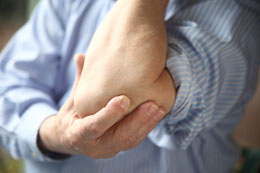Pain in the elbow joint can be caused by several factors, ranging from an overuse injury, a fracture, and tendinitis, to diseases like arthritis and gout. This condition can sometimes affect the range of motion of the elbow joint.

The elbow is the joint where three bones, known as humerus, ulna, and radius meet. Humerus is the bone of the upper arm, while ulna and radius are the inner and outer bone of the forearm. The elbow joint can be termed as a hinge joint, that holds both the upper and the forearm together, and helps move the arm forward and backward, and bend and straighten. Chronic pain in the elbow joint can occur due to various reasons, though most often it is the result of repeated use or the excessive pressure exerted on the joint.
Elbow Joint Pain Causes and Symptoms
Several factors, including excessive pressure exerted on the joint, tendinitis, a sprain or fracture, as well as certain diseases can cause pain in the elbow joint. The following are some of the most important causes of elbow joint pain:
- Tennis elbow or elbow tendinitis is one of the most common conditions that can cause pain in the elbow joint. This condition is also known as lateral epicondylitis, and it affects the tendons that join the muscles on the outer side of the elbow. The range of motion of the elbow joint is usually not affected by this condition.
- Golfer's elbow is the name of medial epicondylitis, that affects the tendons on the inner part of the elbow, and causes pain and discomfort. This condition does not restrict the normal range of motion, as the inner joint is not affected by this condition.
- Another common cause of elbow pain is bursitis. The inflammation of the bursa present at the tip of the elbow is known as olecranon bursitis, which can cause pain in the elbow. It can basically occur due to an injury or trauma, and diseases like rheumatoid arthritis and gout.
- Sometimes, the compression of the ulnar nerve on the inner side of the elbow joint can also cause pain. This condition is termed as cubital tunnel syndrome
- A fracture of the elbow joint or the bones around it, can also cause pain and discomfort in this area.
- Like fractures, a sprain of the ligaments in the elbow area can cause pain in the elbow joint.
- Apart from these, diseases like arthritis and gout that cause inflammation and stiffness of the joints can be associated with this condition.
- Sometimes, septic arthritis or bacterial infection of the elbow joint can cause elbow pain. This condition usually affects people with a suppressed immune system.
- Rarely, bone tumors can be responsible for causing pain in the elbow joint.
Elbow pain can be accompanied by a few additional symptoms, like warmth and swelling of the joint, along with redness and tenderness. Sometimes, the condition can restrict the range of motion of the elbow joint. If the pain is caused by septic arthritis, then fever and chills can also be present.
Elbow Joint Pain Treatment
First of all, you should try to give rest to your elbow as much as possible, by reducing the activities that put pressure on the joint. You can immobilize the joint with the help of an elbow brace. It can reduce the pain and accelerate the process of recovery. The application of an ice pack can prove quite effective in reducing the pain. The application of heat with a heating pad can also provide significant relief.
But if the pain is severe in nature, then medications can be required for pain relief. Usually, aspirin and non-steroidal anti-inflammatory drugs are used to manage the pain. But occasionally, cortisone injections may be required for reducing the pain, especially if it is severe and persistent. In the long run, recurrences of elbow joint pain can be prevented with the help of appropriate exercises.
However, if diseases like arthritis and gout are responsible for causing the pain, then some other treatment options will be required. For managing these conditions, it is better to consult your physician. One should also talk to his or her physician, if elbow pain persists for more than two weeks. This would help find out the underlying causes, and develop a proper treatment plan accordingly.
Disclaimer:
This Buzzle article is for informative purposes only, and should not be replaced for the advice of a medical professional.


 The elbow is the joint where three bones, known as humerus, ulna, and radius meet. Humerus is the bone of the upper arm, while ulna and radius are the inner and outer bone of the forearm. The elbow joint can be termed as a hinge joint, that holds both the upper and the forearm together, and helps move the arm forward and backward, and bend and straighten. Chronic pain in the elbow joint can occur due to various reasons, though most often it is the result of repeated use or the excessive pressure exerted on the joint.
The elbow is the joint where three bones, known as humerus, ulna, and radius meet. Humerus is the bone of the upper arm, while ulna and radius are the inner and outer bone of the forearm. The elbow joint can be termed as a hinge joint, that holds both the upper and the forearm together, and helps move the arm forward and backward, and bend and straighten. Chronic pain in the elbow joint can occur due to various reasons, though most often it is the result of repeated use or the excessive pressure exerted on the joint.